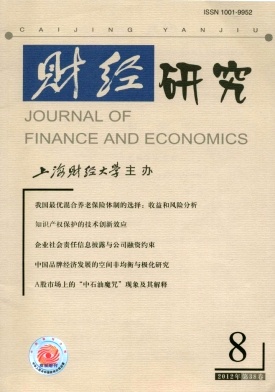人口结构变化与中国贸易顺差:理论与实证研究
财经研究 2012 年 第 38 卷第 08 期, 页码:27 - 38
摘要
参考文献
摘要
文章首先通过构建一个开放经济三期世代交替模型讨论了人口结构变化对中国经常账户余额的影响。理论研究发现,少儿抚养系数的下降会引起储蓄率相对于投资率上升从而形成经常账户盈余,人口老龄化会降低储蓄率从而对经常账户余额产生负向影响。文章然后运用中国1993-2009年省级面板数据进行了实证分析,经验结论与理论模型预测一致,人口结构变化能够解释中国经常账户余额变化的近45%。在控制了其他解释变量后,人口年龄结构变量对经常账户的影响依然显著。文章的估计结果对替代性的经常账户余额指标、人口年龄结构变量的选取以及模型的动态设定也非常稳健。
[1]吕剑.二元经济结构、实际汇率错位及其对进出口贸易影响的实证分析[J].金融研究,2007,(9):90-101.
[2]王仁言.人口年龄结构、贸易差额与中国汇率政策的调整[J].世界经济,2003,(9):3-9.
[3]汪伟.计划生育政策的储蓄与增长效应:理论与中国的经验研究[J].经济研究,2010,(10):63-77.
[4]徐晟.人口年龄结构影响国际收支的传导机制:中国人口红利的削减与国际收支双顺差[J].财贸经济,2008,(5):33-38.
[5]余永定,覃东海.中国的双顺差:性质、根源和解决办法[J].世界经济,2006,(3):31-41.
[6]朱庆.中国特殊国际收支结构原因探析———基于人口年龄结构的视角[J].世界经济研究,2007,(5):36-39.
[7]Batini N,Callen T,McKibbin W.The global impact of demographic change[R].IMFWorking Paper 06/9,IMF,2006.
[8]Brooks R.Population aging and global capital flows in a parallel universe[J].IMF StaffPapers,2003,50(2):200-221.
[9]Domeij D,Floden M.Population aging and international capital flows[J].InternationalEconomic Review,2006,47(3):1013-1032.
[10]Erik L.Capital flows and demographics:An Asian perspective[R].IMF Working Paper08/8,IMF,2008...
[11]Ferrero A.Demographic trends,fiscal policy and trade deficits[R].Meeting Paper,So-ciety for Economic Dynamics,2005.
[12]Feroli M.Capital flows among the G-7Nations:A demographic perspective[R].Fi-nance and Economics Discussion Series 54,2003.
[13]Kim S,Lee J W.Demographic changes,saving,and current account:An analysis basedon a panel VAR model[J].Japan and the World Economy,2008,20:236-256.
[14]Kuijs L.How will China’s saving-investment balance evolve?[R].World Bank PolicyResearch Working Paper No,3958,2006.
[15]Song Zheng,Storesletten K,Zilibotti F.Growing like China[J].American EconomicReview,2011,101(1):196-233.
[2]王仁言.人口年龄结构、贸易差额与中国汇率政策的调整[J].世界经济,2003,(9):3-9.
[3]汪伟.计划生育政策的储蓄与增长效应:理论与中国的经验研究[J].经济研究,2010,(10):63-77.
[4]徐晟.人口年龄结构影响国际收支的传导机制:中国人口红利的削减与国际收支双顺差[J].财贸经济,2008,(5):33-38.
[5]余永定,覃东海.中国的双顺差:性质、根源和解决办法[J].世界经济,2006,(3):31-41.
[6]朱庆.中国特殊国际收支结构原因探析———基于人口年龄结构的视角[J].世界经济研究,2007,(5):36-39.
[7]Batini N,Callen T,McKibbin W.The global impact of demographic change[R].IMFWorking Paper 06/9,IMF,2006.
[8]Brooks R.Population aging and global capital flows in a parallel universe[J].IMF StaffPapers,2003,50(2):200-221.
[9]Domeij D,Floden M.Population aging and international capital flows[J].InternationalEconomic Review,2006,47(3):1013-1032.
[10]Erik L.Capital flows and demographics:An Asian perspective[R].IMF Working Paper08/8,IMF,2008...
[11]Ferrero A.Demographic trends,fiscal policy and trade deficits[R].Meeting Paper,So-ciety for Economic Dynamics,2005.
[12]Feroli M.Capital flows among the G-7Nations:A demographic perspective[R].Fi-nance and Economics Discussion Series 54,2003.
[13]Kim S,Lee J W.Demographic changes,saving,and current account:An analysis basedon a panel VAR model[J].Japan and the World Economy,2008,20:236-256.
[14]Kuijs L.How will China’s saving-investment balance evolve?[R].World Bank PolicyResearch Working Paper No,3958,2006.
[15]Song Zheng,Storesletten K,Zilibotti F.Growing like China[J].American EconomicReview,2011,101(1):196-233.
引用本文
汪伟. 人口结构变化与中国贸易顺差:理论与实证研究[J]. 财经研究, 2012, 38(8): 27–38.
导出参考文献,格式为:
本期封面
相关论文





 8388
8388  4201
4201

